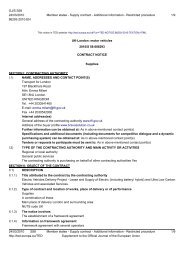Life cycle costing (LCC) as a contribution to sustainable construction ...
Life cycle costing (LCC) as a contribution to sustainable construction ...
Life cycle costing (LCC) as a contribution to sustainable construction ...
You also want an ePaper? Increase the reach of your titles
YUMPU automatically turns print PDFs into web optimized ePapers that Google loves.
Towards a common European methodology for <strong>Life</strong> Cycle Costing (<strong>LCC</strong>) – Guidance Document<br />
56<br />
<strong>LCC</strong> process<br />
Objective<br />
Preliminary<br />
identification<br />
of parameters<br />
and analysis<br />
requirements<br />
Confirmation<br />
of project and<br />
facility<br />
requirements<br />
Assembly of<br />
cost and<br />
performance<br />
data<br />
The main objective w<strong>as</strong> <strong>to</strong> use and test tenders and contracts with economically optimised structural<br />
solutions on the b<strong>as</strong>is of life <strong>cycle</strong> cost. Tenders consisted of initial design cost + initial building costs (and<br />
possibly maintenance costs), but the lowest tender w<strong>as</strong> determined by the initial costs plus the Net<br />
Present Value (NPV) of the maintenance prognosis.<br />
The Ministry of Transport, Public Works and Water Management (RWS) carries out a significant<br />
proportion of building work, which are tendered with a ten <strong>to</strong> fifteen year period of maintenance. This<br />
period is determined on the b<strong>as</strong>is of the life <strong>cycle</strong> cost analysis of pavement/surfacing. Many other<br />
components or structures of a highway/mo<strong>to</strong>rway have a significantly higher life expectancy and therefore<br />
longer term maintenance risks are insufficiently covered in this period.<br />
Maintenance is generally the result of choices made during design. A key feature of civil engineering<br />
projects is the fact that the first significant maintenance activity typically takes place many years after the<br />
initial build h<strong>as</strong> been completed. In the tenders for the A4 Burgerveen – Leiden on the b<strong>as</strong>is of life <strong>cycle</strong><br />
cost, long term cost forec<strong>as</strong>ts were taken in account, even though these costs would never be the<br />
responsibility of the contrac<strong>to</strong>r. Assessment of the NPV of the maintenance forec<strong>as</strong>t w<strong>as</strong> used <strong>to</strong><br />
compare the different tenders.<br />
The Dutch government currently specifies a general discount rate of 4 %. For large scale projects or high<br />
risk projects this rate may be readjusted <strong>to</strong>, in some c<strong>as</strong>es, a more conservative rate of 3%.<br />
The environmental performance is not a strong decision criterion.<br />
Risk and sensitivity analyses are not part of the requirements for <strong>LCC</strong> driven tenders although focus is on<br />
quality.<br />
A difficult <strong>as</strong>pect with applying life <strong>cycle</strong> cost criteria is determining the most likely life <strong>cycle</strong> period or<br />
lifespan. Choices made during the design determine the technical lifespan of a structure and in most<br />
c<strong>as</strong>es the actual lifespan is determined by functional demands (such <strong>as</strong> changing road widths or permitted<br />
axel-loads). Data collected on demolished bridges (viaducts) from the l<strong>as</strong>t 20 years shows that the life<br />
expectancy of such structures is approximately 80 years.<br />
In most c<strong>as</strong>es, the functional purposes of a structure would still apply at the end of a technical life. Costs<br />
for demolition and replacement should therefore be taken in <strong>to</strong> account, <strong>as</strong>suming replacement by a<br />
structurally similar solution.<br />
Applying an exact lifespan in a life <strong>cycle</strong> cost analysis is arbitrary because comparing different alternatives<br />
may be confused by the selected combination of a lifespan and applied discount rate. Applying an infinite<br />
time horizon may be more informative, especially when uncertainties in lifespan are taken in<strong>to</strong> account in<br />
probabilistic models. The <strong>as</strong>sumption is that structures will be demolished and replaced with an average<br />
interval (repetitive life <strong>cycle</strong>). The functionality of a demolished structure remains and will be fulfilled by a<br />
new structure. This <strong>as</strong>sumption h<strong>as</strong> only a limited impact on life <strong>cycle</strong> cost results (compared <strong>to</strong> a set time<br />
frame) because costs generated in the distant future contribute little <strong>to</strong> the life<strong>cycle</strong> cost <strong>to</strong>tal due <strong>to</strong> the<br />
effects of discounting.<br />
The comparison of tenders w<strong>as</strong> carried out using a software <strong>to</strong>ol, recently developed by Rijkswaterstaat a<br />
‘Cost Analysis <strong>Life</strong><strong>cycle</strong> Model (CALM)’, a pro<strong>to</strong>type <strong>to</strong>ol <strong>to</strong> facilitate a tender process on the b<strong>as</strong>is of life<br />
<strong>cycle</strong> costs. CALM contains a small datab<strong>as</strong>e with a variety of mainstream structure-types, their correlated<br />
components and their standardised maintenance strategies (referred <strong>to</strong> earlier) most commonly used in<br />
and over highways in the Netherlands. Each of these structure-types and components is provided with a<br />
predetermined ‘costs per unit’ for future maintenance. These ‘costs’ are made up of averages, b<strong>as</strong>ed<br />
partly on theoretically determined deterioration behaviour and partly on deterioration experience. These<br />
costs per unit are then converted <strong>to</strong> a Net Present Value (NPV) per unit.<br />
Concerning an overall structure-type all costs are “All-inclusive”. This means that not only ‘out of pocket’<br />
costs are negotiated but V.A.T (taxes) and company/civil service costs are included in the cost per unit.<br />
Costs per unit for components consisting merely of ‘out of pocket’ costs are multiplied with an ‘overhead<br />
fac<strong>to</strong>r’ in order <strong>to</strong> determine ‘All-in costs’. This fac<strong>to</strong>r determined for each structure type.<br />
CALM distinguishes design costs (all costs related <strong>to</strong> the design process (V.A.T. included)) and realisation<br />
costs (all costs related <strong>to</strong> the actual building process (i.e. labour and materials etc.) (V.A.T. included)).<br />
CALM also allows for exploitation costs - the <strong>to</strong>tal of costs expected <strong>to</strong> maintain (newly) acquired functions<br />
on a required level and within the required (legal) boundaries, this means all activities <strong>to</strong> keep a function<br />
‘running’, including maintenance. A structure is maintained solely in order <strong>to</strong> fulfil and thus maintain a<br />
function. These costs are not included in the contract sum.<br />
These costs can be divided in<strong>to</strong> (i) costs for replacing complete structure-for each structure type the<br />
average lifespan is determined. On the b<strong>as</strong>is of this interval costs for replacement are set out infinitely; (ii)<br />
costs for Inspection - the average yearly costs made for a diversity of inspection types performed on each<br />
particular structure type ; (iii) costs for Routine Maintenance - the average yearly costs made for routine<br />
maintenance performed on each particular structure type and (iv) costs for Gross Maintenance - the major<br />
Davis Langdon Management Consulting May 2007







